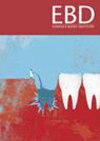Matters of the heart; antibiotic prophylaxis for prevention of infective endocarditis—are we getting it right?
IF 2.3
Q3 Dentistry
引用次数: 0
Abstract
Sperotto F, France K, Gobbo M et al. Antibiotic prophylaxis and infective endocarditis incidence following invasive dental procedures: a systematic review and meta-analysis. JAMA Cardiol 2024; 9:599. https://doi.org/10.1001/jamacardio.2024.0873 . This systematic review evaluates the association between antibiotic prophylaxis (AP) and the incidence of infective endocarditis (IE) following invasive dental procedures (IDPs). A systematic search was conducted across PubMed, Cochrane-CENTRAL, Scopus, Web of Science, Proquest, and Embase, from inception to May 2023. Observational studies, including case-control, case-crossover, cohort, self-controlled case-series, and time-trend studies were included. Data were extracted independently, and structured tools were used to evaluate study quality. A random-effects meta-analysis estimated the pooled-relative risk (RR) of developing IE in high-risk subjects who received AP compared to those who did not. Of 11,217 identified records, 30 studies met inclusion criteria, comprising 1,152,345 IE cases. Among 12 relevant studies, five found a significant protective effect of AP in high-risk subjects. Four studies were combined in meta-analysis and showed AP was associated with a significantly lower IE risk in high-risk individuals (pooled-RR = 0.41, 95% CI: 0.29–0.57). No significant association was found for moderate- or low/unknown-risk subjects. Time-trend studies showed mixed results: some indicated increased IE incidence after AP guideline changes, while others found no change or a decrease. Despite limitations, this review provides an important update on AP use in preventing IE after IDPs. Evidence supports AP use for high-risk individuals, while data remain inconclusive for moderate-risk populations, highlighting the need for further research.心事;心事;抗生素预防感染性心内膜炎——我们做得对吗?
注:Sperotto F, France K, Gobbo M等。侵入性牙科手术后抗生素预防和感染性心内膜炎的发生率:一项系统回顾和荟萃分析。JAMA Cardiol 2024;9:599。https://doi.org/10.1001/jamacardio.2024.0873。目的:本系统综述评估了侵入性牙科手术(IDPs)后抗生素预防(AP)与感染性心内膜炎(IE)发生率之间的关系。材料和方法:系统检索PubMed、Cochrane-CENTRAL、Scopus、Web of Science、Proquest和Embase,检索时间从成立到2023年5月。观察性研究包括病例对照、病例交叉、队列、自控病例系列和时间趋势研究。数据独立提取,并使用结构化工具评估研究质量。一项随机效应荟萃分析估计了接受AP治疗的高危受试者与未接受AP治疗的受试者发生IE的综合相对风险(RR)。结果:在11,217份确定的记录中,30项研究符合纳入标准,包括1,152,345例IE病例。在12项相关研究中,有5项研究发现AP对高危人群有显著的保护作用。在荟萃分析中合并了四项研究,结果显示AP与高危人群显著降低IE风险相关(合并rr = 0.41, 95% CI: 0.29-0.57)。在中度或低风险/未知风险受试者中未发现显著相关性。时间趋势研究显示了不同的结果:一些研究表明在AP指南改变后IE发病率增加,而另一些研究发现没有变化或减少。结论:尽管存在局限性,但本综述为应用AP预防IDPs后IE提供了重要的更新。证据支持高危人群使用AP,而中等风险人群的数据仍不确定,这突出了进一步研究的必要性。
本文章由计算机程序翻译,如有差异,请以英文原文为准。
求助全文
约1分钟内获得全文
求助全文
来源期刊

Evidence-based dentistry
Dentistry-Dentistry (all)
CiteScore
2.50
自引率
0.00%
发文量
77
期刊介绍:
Evidence-Based Dentistry delivers the best available evidence on the latest developments in oral health. We evaluate the evidence and provide guidance concerning the value of the author''s conclusions. We keep dentistry up to date with new approaches, exploring a wide range of the latest developments through an accessible expert commentary. Original papers and relevant publications are condensed into digestible summaries, drawing attention to the current methods and findings. We are a central resource for the most cutting edge and relevant issues concerning the evidence-based approach in dentistry today. Evidence-Based Dentistry is published by Springer Nature on behalf of the British Dental Association.
 求助内容:
求助内容: 应助结果提醒方式:
应助结果提醒方式:


